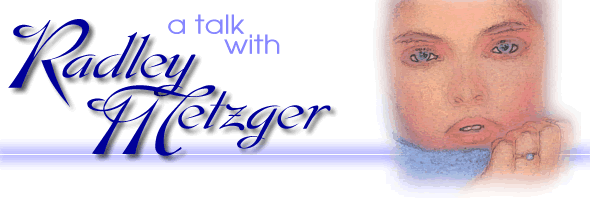
MONDO DIGITAL: Your first film, Dark Odyssey, has received a positive critical response since its recent debut on video, even though it doesn't bear any surface similarities to your later work. How do you feel about the film looking back on it now?
RADLEY METZGER:The critical response has been particularly welcome for Dark Odyssey because I always felt it was treated like a kind of Cinderella stepchild at the time. The New York Times was good, for a couple of first time directors, when it opened in New York in 1958, but most people dismissed it because it didn't have any credentials, which you needed at the time. I can't really comment on the film itself because I haven't seen it since we completed it 42 You've named several cinematic influences throughout the years - John Farrow, Michael Powell, Orson Welles. In what ways do you find them important?
They were important for me because, when I came of age, American films were fairly uniform and these were directors who brought a unique energy to storytelling. As examples: John Farrow had one of the most fluid cameras of the period. I think he was the American Max Ophuls; The Big Clock is an excellent example. Michael Powell: Colonel Blimp and The 49th Parallel made a big impression on me. A funny incident-- some years ago, Variety mentioned me in a review of Peeping Tom - comparing styles, etc. I must have been guilty of what Hitchcock called "unconscious plagiarism." I thought it interesting because Peeping Tom was the one Powell film I've never seen. Orson Welles: Any Welles film is a course in filmmaking. His rhythms were incredible. He brought the energy of radio to film. Journey into Fear was one of my favorites.
Most of your films make excellent use of music. How do you decide what kind of music to use, and what was your working relationship like with Piero Piccioni, Georges Auric, and Stelvio Cipriani? Do you still control the rights to the music?
My relationship with the composers was fairly standard. We'd discuss the intent of the author and the overall texture of the sound. Oddly enough, Stelvio Cipriani was my only first choice. Many of your films are adapted from novels or various other literary sources - La Dame aux Camellias, Carmen, Pygmalion, Therese and Isabelle, Naked Came the Stranger. How much do you feel the written word has had an impact on your films, and do you enjoy the kind of classical structure afforded by adapting novels?
You could add Misty and The Cat and the Canary to that list. The reason I turned to so many adaptations was because I didn't know a lot about structure - narrative structure. I came from the editing room, and I wasn't very secure in creating story structure. I didn't do free form films - which were popular at the time - so I felt very secure having heavyweights like Prospere Merimee and Alexander Dumas on my side.
A number of Audubon titles which you didn't direct also bear your unmistakable personal "stamp," particularly The Frightened Woman and The Libertine. Are there any films in which you had some input, editorial or otherwise (i.e., I Spit on Your Grave," I, a Woman, etc.) with which you're particularly satisfied?
I Spit on Your Grave was very satisfying - the original French film, not the horror movie that took the title. I hadn't yet made a film after Dark Odyssey so a lot of frustrated energy went into Spit. It was a movie nobody wanted because it had a racial theme; it was made in France and took place in America, and contained a lot of mistakes. I did a lot of re-editing, and the film was the first commercial success for Audubon Films. It was very basic work - Editing 101 - but it impressed a lot people who didn't have a technical background. I, a Woman was a little slow for American tastes, so we gave it a different pace. I always enjoyed editing - from whence I came.
A number of terms have become synonymous with your filmmaking style - "elegant," "aristocratic," "continental," "precise." How would you describe it?
In the area of eroticism, I think it's easier to How much impact do you think moving from editor to director had on your methods?
Beginning as an editor was crucial. I think it's the only way to begin a film career. It happened by chance because it was the only work available at the time. After being a schlepper on a film, I moved into the cutting room with it and was able to get into the union. Learning editing is like a writer learning grammar. It gives you enormous confidence. And it helps at the end of a day's shooting when you ask the eternal question, "Is this stuff going to make any sense?"
Your one mainstream thriller, The Cat and the Canary, is also one of the few titles you didn't distribute yourself. How much control did you ahve over the production,s ucha s casting, crew, and promotion, and what kind of experience did you have shooting a British production as opposed to the usual French or Italian?
The Cat and the Canary wasn't special in the input area. I had know the producer, Richard Gordon, for many years, and we had no problems. The crews were very different, however. I found English When you briefly moved to hardcore, your five Henry Paris titles were shot as both soft and hardcore versions. Do you have a preference for one over the other? Are there any plans to ever make The World of Henry Paris available on video?
I think I prefer the hard-core although the soft versions have comedic scenes that I liked but would have made the hard-core versions too long. The Best of Henry Paris should be released on video by the end off the year. The video release of The Private Afternoons of Pamela Mann is severely cut, most notably the absence of the entire garage sequence. Was this scene considered objectionable, and will the soft version ever be released?
All the Hanry Paris films have been severely cut. The Private Afternoons of Pamela Mann was no exception. The scene you refer to was even cut in Sweden because it contains non-consensual sex - although it's all make-believe in the film. The original, full versions of all the Henry Paris films should be out this year. It's the first time in 25 years.
Two films you shot under your own name were released in both soft and semi-hardcore versions, Score and The Punishment of Anne [The Image]. How did you decide how to market and release these titles originally? Was the intention for Score to cross over into a semi-mainstream audience, as it now has after its release in theaters and on video?
There was hard-core in Score - between the boys - but considering the bisexual nature of the story, we The Punishment of Anne is your only adaptation of a novel by Alain Robbe-Grillet (though under a pseudonym), but the rest of your films don't seem very concerned with S&M. Do you see any similarities between your work, and what led you to choose that particular novel?
I think the fabric and atmosphere of the story was the same as my previous films. S&M was suggested in a few of the early films and I thought it a logical area to explore after Score.
Little Mother is more based in hard "reality" than your other work because of its semi-biographical basis. How did you approach working on a political subject, and how much of it did you have to alter to obtain an "R" rating?
Little Mother was exciting because it allowed me to do what I really enjoyed: creating a total environment - in this case, an entire country. It was pretty much produced as an "R".
Your range of actors ranges all the way from European arthouse names like Anne Vernon and Nino Castelnuovo (The Umbrellas of Cherbourg) to adult film performers, yet you manage to elicit excellent performances in every case. What's your approach to directing actors, and how do you select the women for your films? It's been noted in fact that many of your actresses look more sexy fully dressed than most other actresses do unclothed; is there a method to finding actresses with this quality?
I think I used a deductive method - rather than an additive one. That is, I would always ask to see the worst film an actor had previously made. That way, I'd know what to emphasize - and more important, what to avoid. And I would over-shoot, so I had the luxury of not having to use every frame that I shot. A little like making soup stock. As far as finding suitable actresses, the secret word is patience. If you have a start date without a firm cast, you can have a problem.
The intellectual references in your films often give them a completely unique feeling, such as opening The Lickerish Quartet with a Pirandello quote. How did you trigger audiences to start paying attention to the meaning of the entire film instead "the good scenes?"
Erotic movies are like musicals. They're judged on what happens between the numbers, not just during. So every scene has to be approached the same. We never worked harder on the sex than anything else. If the audience is not involved in the basic premise of the film, they probably won't think it's very sexy. This doesn't hold true if you're first with something, like The Jazz Singer or The Robe or Deep Throat. But I don't think Your recent interest in homeopathic medicine is quite in keeping with your own upbeat, health-oriented views on life, including your depiction of sex as a mutually beneficial, positive force. How do you feel about the arrival of the AIDS era, which tempered the more carefree attitudes in the '70s and early '80s? If you did another erotic film, do you think the change in sexual standards would have any effect on how you presented love scenes?
AIDS would not concern me if I did another erotic film because I would set it in a pre-AIDS period. I didn't do pure realism. I never dealt with unintended pregnancy, or herpes or impotence. There's more than enough film literature on those subjects. I presented an idealized enactment of sex - as a unifying force between people.
Could you describe your work with First Run Features in preparing your films for video?
Working with First Run Features has been ideal. Together we agree on the release order of the titles. We've used mostly original materials in the mastering and the art work for the jackets is from the original pressbooks. It meant a lot of hours in the vaults - but it was worth it.
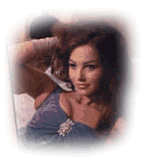 years ago. Several recent critics have compared it to Cassevetes - which is funny - because Shadows was made the same year and no one mentioned it at the time. I just read a review which said that Dark Odyssey was a Scorsee film with Greeks instead of Italians.
years ago. Several recent critics have compared it to Cassevetes - which is funny - because Shadows was made the same year and no one mentioned it at the time. I just read a review which said that Dark Odyssey was a Scorsee film with Greeks instead of Italians.
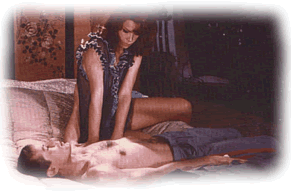
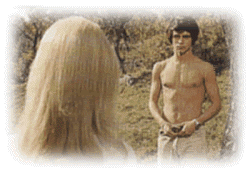 I had heard his score for The Frightened Woman and was impressed and hired him for The Lickerish Quartet. On Therese and Isabelle, we had hired Georges Delerue. He was wonderful. He lent us his tapes from Jules and Jim to use in our scratch mix. But unfortunately, he couldn't continue. I think there was illness in the family, but I was really blessed in getting Georges Auric.
I had heard his score for The Frightened Woman and was impressed and hired him for The Lickerish Quartet. On Therese and Isabelle, we had hired Georges Delerue. He was wonderful. He lent us his tapes from Jules and Jim to use in our scratch mix. But unfortunately, he couldn't continue. I think there was illness in the family, but I was really blessed in getting Georges Auric. 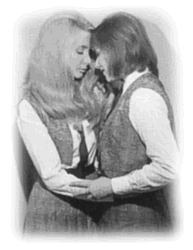 He was the first name in French film music. At the time, he was the head of the Paris Opera - he'd done all the Cocteau films - but he worked on the movie as if it were his first audition. I think the effectiveness of Therese was in no small way due to his score. He wrote to the voices - which, with all the narration, was critical. A similar thing happened on Camille 2000. I had engaged Armondo Trovajoli, who had done a fabulous score for The Libertine, but he couldn't continue at the last minute. Again, I was blessed in getting Piccioni. Audubon Films has the rights to the music.
He was the first name in French film music. At the time, he was the head of the Paris Opera - he'd done all the Cocteau films - but he worked on the movie as if it were his first audition. I think the effectiveness of Therese was in no small way due to his score. He wrote to the voices - which, with all the narration, was critical. A similar thing happened on Camille 2000. I had engaged Armondo Trovajoli, who had done a fabulous score for The Libertine, but he couldn't continue at the last minute. Again, I was blessed in getting Piccioni. Audubon Films has the rights to the music.
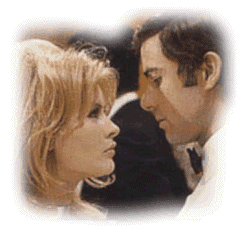 involve the audience if you deal with rich people. When you try to create total environments, you don't want to deal with the question of how your characters make a living. So I had to keep everything very upscale. It's a kind of seduction. I think audiences can be more accepting of a film if the atmosphere is different from their own. Hence the "elegant". In order to have more money for the production, I shot in Europe. Hence "continental."
involve the audience if you deal with rich people. When you try to create total environments, you don't want to deal with the question of how your characters make a living. So I had to keep everything very upscale. It's a kind of seduction. I think audiences can be more accepting of a film if the atmosphere is different from their own. Hence the "elegant". In order to have more money for the production, I shot in Europe. Hence "continental."
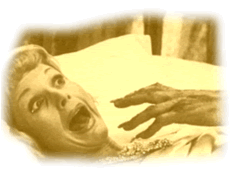 filmmaking much more formal and much more structured than on the continent. It didn't lend itself to any deviation from the schedule. I met someone recently who teaches The Cat and the Canary as an example of how to get the most from a limited budget.
filmmaking much more formal and much more structured than on the continent. It didn't lend itself to any deviation from the schedule. I met someone recently who teaches The Cat and the Canary as an example of how to get the most from a limited budget.
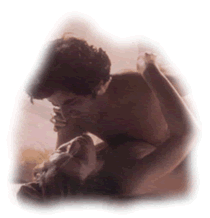
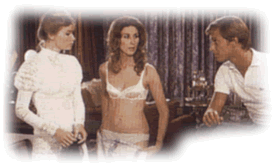 thought it would limit the theaters that would play it. We were trying to reach a mainstream audience.
thought it would limit the theaters that would play it. We were trying to reach a mainstream audience.
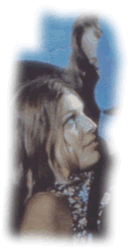 I was ever first with anything.
I was ever first with anything.
Photos from the following films (from top to bottom): The Alley Cats; Carmen, Baby; The Lickerish Quartet; Therese and Isabelle; Camille 2000; The Cat and the Canary; The Opening of Misty Beethoven; Score; The Private Afternoons of Pamela Mann.
